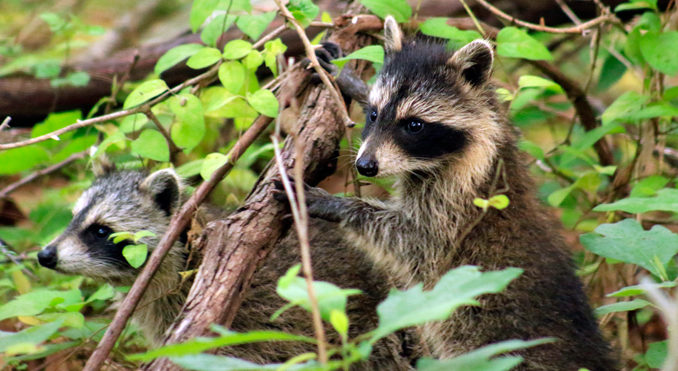
by Dell Cullum

One of the more common species of wildlife here on the east end is the raccoon, and although their natural habitat is shrinking at an accelerated rate, they are quickly acclimating themselves to their new man made surroundings. This quick learning ability to overcome obstacles is the raccoons specialty, and the reason why their populations have increased tremendously over the past few years. Rather than revisit the general knowledge about raccoons, let me offer some localized information you may or may not know.
Because raccoons acclimates at different times for different reasons, each raccoon sighting by humans may seem different, which in some cases creates alarm. Although raccoons are generally nocturnal, it’s not uncommon to see raccoons during the day here on the east end, particularly when food is abundantly available, or when they are disturbed by landscaping or construction. Females that spend their nights nursing during the birthing season (April thru July) will often take a daytime stroll looking for food, and after being suckled on all night by 2 to 10 little kits, their haggard appearance usually promotes unnecessary concern when seen.
Here on the eastern end of Long Island, you could find a raccoon swimming in your pool, eating with your cats, or turning your chimney or attic into a nursery, more often than you would see them while hiking through the woods. Their clever behavior, along with their well known vulnerability to the rabies virus, have long spawned rumors about these masked critters of the night and ultimately gave the animal a frightful and dangerous reputation. Thanks to the fine folks at Cornell, rabies was eradicated from most of the Long Island raccoon population in 2006 through the introduction of an edible vaccine. There hasn’t been a case of a rabid raccoon on the east end in well over 50 years.
Unfortunately, our raccoons are very susceptible to distemper, which they can spread to each other as well as dogs but, not contagious to humans. If not vaccinated for distemper, the viral disease will first attack the gastrointestinal and respiratory system before reaching the central nervous system and ultimately result in death. A sick raccoon will act disoriented and walk in circles. As the illness worsens, the animal may have seizures which often results in the chattering of teeth. This is almost always misunderstood for rabid behavior. Distemper does not make the animal aggressive like rabies would, and almost all distempered raccoons will ultimately curl into a fetal position, fall into unconsciousness, stop breathing and die. This usually takes between 48 and 72 hours.
As far as some of the other rumors, one must simply put themselves in the animals position to understand the truth. A great example is the old warning, “If you corner a raccoon, it’ll kill you”. Truth is, it probably won’t kill you, particularly if it can get around you but, an average dog could be taking a chance. More importantly, if another species that you can’t communicate with, corners you with possible harmful intent, what do you do? If your instinct is to survive, you do exactly what a raccoon would do,… whatever it takes.
I’ve raised or rehabbed many raccoons over the years and it’s a never ending learning experience. Just when you think you know everything about them, they show you something new, and it’s usually because human intervention has forced them into learning something new. The raccoon is clearly an animal whose habits conform to their surroundings.
Our local raccoons are a great example. During the summer months, when all the restaurants are in full operation, there is an endless buffet of human food waste available in dumpsters each night for these critters to feast on. Raccoons are omnivorous and not much offends their pallet but, when the remnants of surf and turf is easily found, it makes berries, bugs and rodents not so appealing.
Unlike the raccoons who eat naturally, these seasonal dumpster diners get big and plump, with nice shiny coats. The well fed females tend to have larger litters with higher survival rates. Raccoons give birth once a year with litters that vary from 2 to 10. Typically, an average litter is 2 to 4 but, I’ve noticed the average number increase to 6 over the past several years. I’ve also trapped some of the largest raccoons I’ve ever seen, right here in Montauk.
As each summer eventually comes to an end, so does the dumpster buffets, and that’s when the problems really start. It’s all fun and games until the food stops. When the restaurants close and the dumpsters go empty, these masked critters don’t give up easily. They know where the food came from, and they will make a grand attempt to get to it by any means, even if they have to create an entry through the roof. If they can’t get into that roof, they’ll visit the neighbors and all the homes nearby. If they are lucky, and they usually are, they’ll find that homeowner who isn’t that tidy with their trash, or even better, a vacant residence with an old cedar shingle roof. That’s when the off season cycle of destruction begins.
How do you better your odds against these misunderstood little geniuses? Simple, keep your trash inside, in your garage or in a secure shed until pick up or disposal. Do not leave your grill outside. Do not leave soaps and shampoos in outdoor shower stalls. Eliminate any exterior water sources. Don’t allow pool water to stand above pool cover. Remove all bird feeders and suet cages at days end. Most importantly, keep them from gaining access to your roof. Cut your trees back at least 2′ from gutter line and allow no branches to hang over your roof where gravity can feed them down. Remove lattice or climbing vines that act as ladders to the roof. Chimney caps are also important. I like to tell my customers, “Keep them off your roof and they’ll move on to your neighbors”.
Folks, if wildlife isn’t causing you property or structural damage, then enjoy it to the fullest. Don’t consider it a problem if you see a raccoon walk across your back yard but rather, enjoy the experience of observing our awesome wildlife. After all, our goal should be to live WITH our wildlife, and not to eliminate it.
Remember, Wildlife Matters.
~ Dell Cullum
_________________________________
Evelyn Alexander Wildlife Rehab and Rescue: 631-728-WILD
Hampton Wildlife: 631-377-6555

